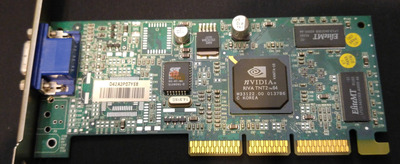First post, by BitWrangler
- Rank
- l33t++
Hey folks,
I've had this card years, but never really LOOKED at it, and when I did, I was somewhat amazed.... some madlad at the factory equipped it with 5 nanosecond RAM.
As far as I understand it, the Vanta is the cut down version of the cut down version, I see 133Mhz memclocks mentioned VS 143 for the "full fat" M64. That means it's got RAM not one speed grade, but two speed grades higher than it needs.
September 2001 date on the back of the thing, so a couple of years since release and probably the most budgety budget card to have Nvidia on it at the time. I wonder if it was even a 9/11 thing, nothing flying for a week after, so maybe they completed an order with higher spec? Or maybe there's more out there prior to this date and it was just more economical to bulk buy the 5ns to use on everything, rather than some small order of slow stuff.
If I currently had a decent AGP system running I'd whip it in there right smart and see how high it would go. I kinda feel mildly annoyed, like it's another thing on my to-do list now, "page 129 volume III, Item# 5763: Benchmark crappy old Vanta16 and push it to 3DMark record." 🤣 (Yeah I know, the core might really suck)
Here 'tis in all it's goofy glory...
Unicorn herding operations are proceeding, but all the totes of hens teeth and barrels of rocking horse poop give them plenty of hiding spots.
